The most delicious strawberry I’ve ever tasted came from my grandparent’s garden, in Sofia, Bulgaria. It was the size of a gummy, looked like a woodland ruby, and tasted like it had grown in the Swiss Alps. The second-best strawberry came from a vertical farm in New Jersey. It was the color of a white nectarine, sweet and delicate, and it was picked by a robot.
About a 90-minute drive from New York City, near a sprawling field of solar panels, stands a pale-colored building that, just some years ago, was a factory that produced plastics. Today, it grows some of the world’s most expensive strawberries.
If you’re a frequent patron of Michelin-star restaurants, or if you shop at Whole Foods on the East Coast, you may have heard of the company Oishii. Oishii, meaning “delicious” in Japanese, first made headlines in 2021 for its outrageously expensive Omakase strawberries, which at the time cost $50 for a tray of eight. Since then, the cost has dropped to $11-15 depending on the retailer, due in large part to Oishii scaling up its farming operations.
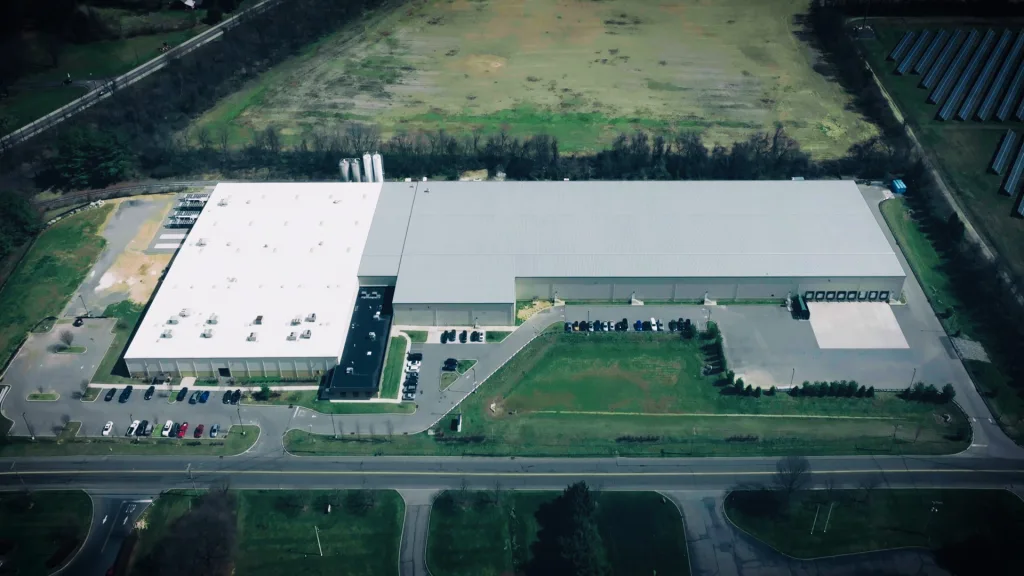
Until recently, the company grew all of its produce in a vertical farm in Jersey City, New Jersey. But with the opening of its new Amatelas farm in Phillipsburg, New Jersey, Oishii is on a mission to build a replicable vertical farming model that will help it become a global produce brand. The goal is to capture people’s rapidly growing appetite for berries—a market that has grown more than 40% in the past five years.
Excluding Japan, where a booming luxury fruit market can command upwards of $780 for ultra-high-end strawberries, Oishii’s berries are some of the most expensive on the market. The Oishii team plans to have categories of berries at several price points, so people can choose the level of splurge based on their priorities. As Oishii’s CFO, John Reed, told me during a recent visit to the Phillipsburg farm: “There’s an occasion for $10 strawberries, for $20 strawberries, and there’s an occasion for a $4 pack of strawberries.”
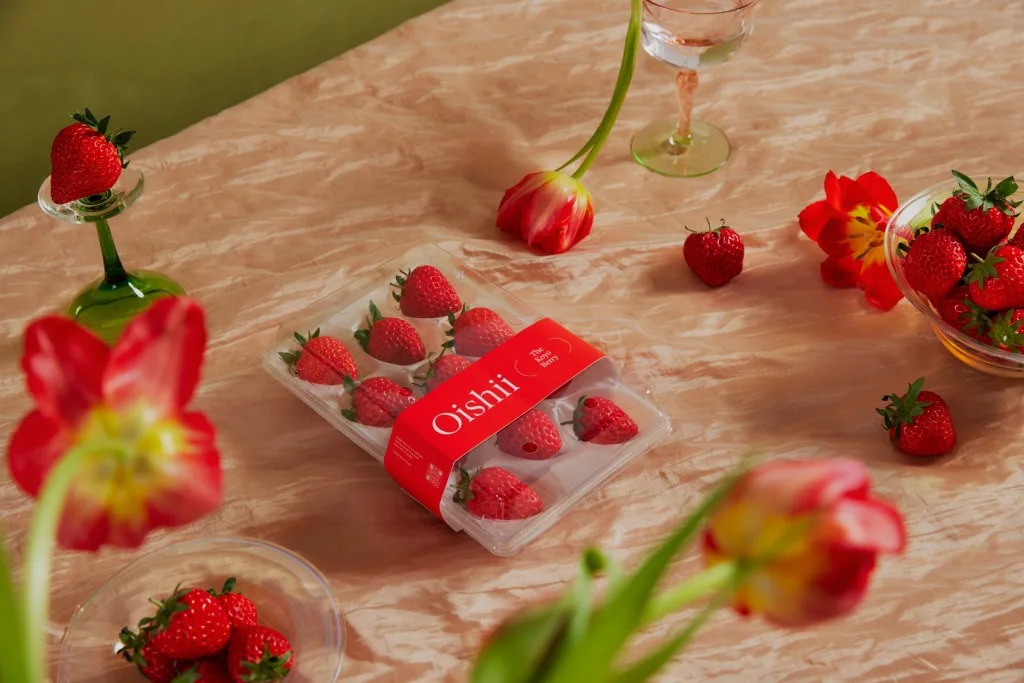
Building a blueprint
In 2015, Hiroki Koga, Oishii’s cofounder and CEO, left his job in Tokyo as a consultant for Deloitte (where he helped huge corporations implement vertical farms) to get an MBA from UC-Berkeley. There, he met agriculture entrepreneur Brendan Somerville, who became Oishii’s cofounder.
Oishii began with a suitcase of strawberries imported from Japan, a first round of seed money, and a small warehouse in New Jersey where the founders often slept, and pollinated strawberry flowers by hand. The opening of the new farm in Phillipsburg marks a significant bend in the road to global domination.
Spanning more than 237,500 square feet, Amatelas, named after the mythical Japanese sun goddess, can grow more than 20 times the number of berries than its previous facility in Jersey City (though the company declined to say exactly how many strawberries it can produce). Unlike Oishii’s first farm, Amatelas runs entirely on solar power and recycles 95% of the water it uses. It is also home to 50 robots that use AI and computer vision to capture more than 60 billion data points annually to understand the optimal ripeness of a strawberry before they can pick them.
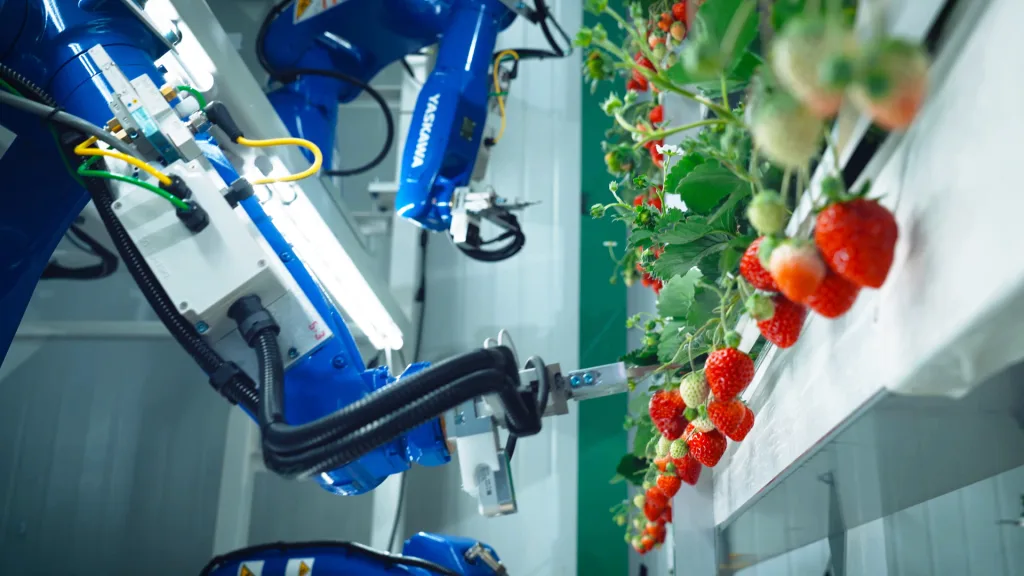
On a clammy day in June, four robots busied themselves as I watched through a small window. Though I wasn’t allowed inside the room where the strawberries grow, I still had to change into clean, silken scrubs, slide into clogs, put on a face mask, gloves, and a hairnet, and walk through an “air shower” designed to blow off pesticides and other contaminants.
For a couple of seconds, the robots appeared confused as they swiveled around looking for a ripe target. But soon enough, one robot zeroed in on a perfectly red strawberry, it opened its metal claws, which looked more like jewelry pliers, and gently tore the berry off its stem. The robot then rotated 90 degrees, and dropped the berry inside a tray that, once full, would glide away on a conveyor belt and into a glacial packing room, where packers clad in all-white uniforms would inspect the strawberries one by one and sort them by size.
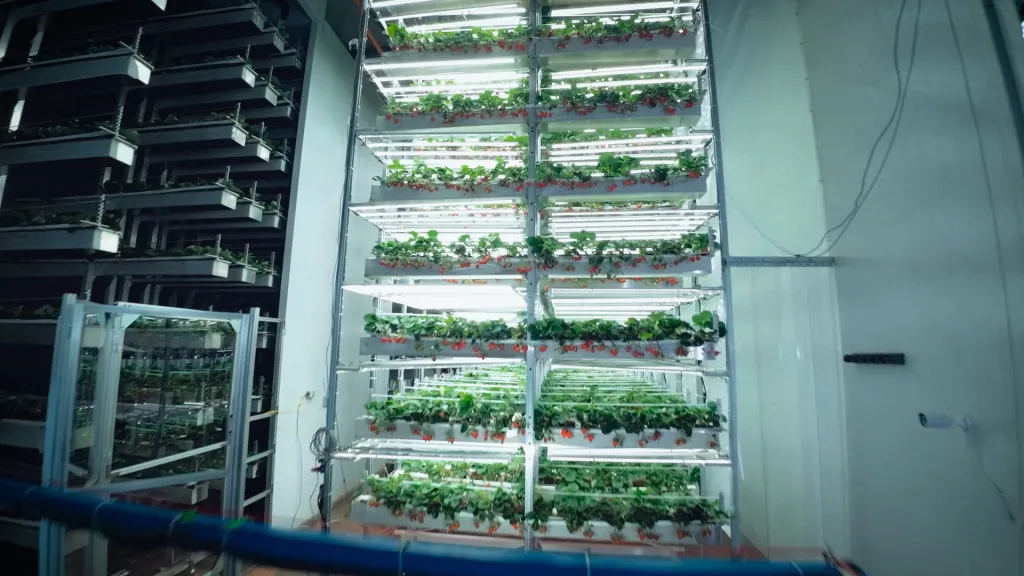
The farm holds hundreds of racks, each stacked with eight rows of planters. Instead of roving robots, the racks slowly snake around the room, almost like a ski lift. Koga says moving racks was easier—and safer—than moving the robots. After picking its strawberry, the robot “washed its hands” by flapping its claws inside a little water-filled vessel, and went back on the hunt. A few seconds in, it realized there were no more ripe strawberries in sight, and the room went dark. If I had stayed a bit longer, Koga says I would have seen the entire system of racks begin to move.

A farm or a lab?
Oishii’s indoor farm was designed to simulate the exact environmental conditions of an undisclosed town in the foothills of the Japanese Alps. On my tour, I crossed a cavernous room filled with pipes and 50 or so gargantuan water tanks that collect, clean, recycle, and redistribute the water throughout the system to irrigate the berries. Further into the building, I peeked inside the “central command unit” where various charts and numbers (collected from the myriad sensors around the farm) flickered on two wall-mounted screens.
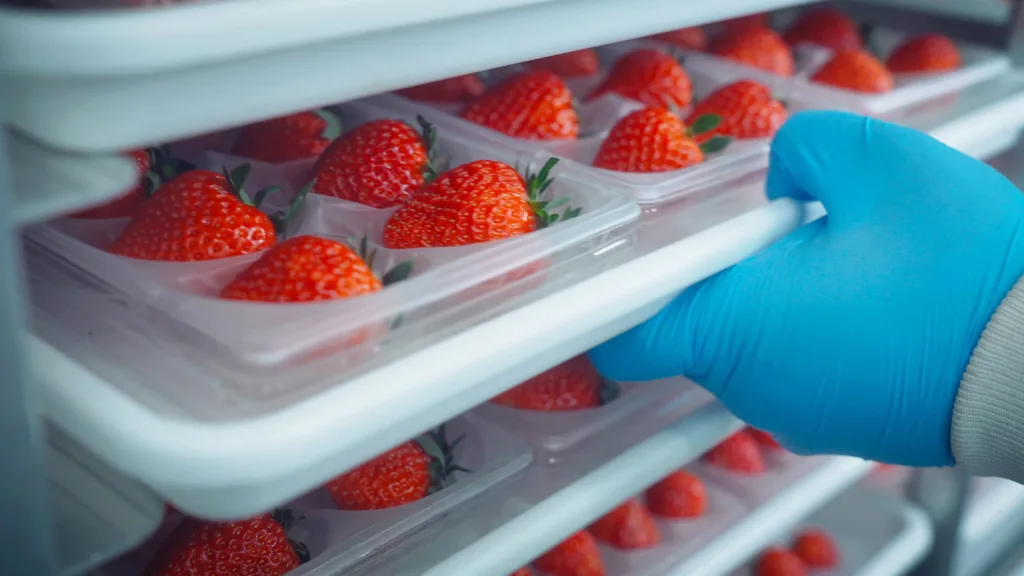
The Oishii farm is more akin to a lab, but it’s a promising alternative to conventional farms, which require expansive lands to grow crops and often use synthetic fertilizers and pesticides to maximize yields and preserve the produce for long-distance transport. Unlike outdoor farms, Oishii’s farm is not subject to heat waves, droughts, and diseases.
Despite a rash of vertical farms filing bankruptcy or laying off workers, the global vertical farming market is expected to surpass $35 billion by 2032. Growing food in a vertical farm, where technology allows farmers to play God, means companies can, in theory, grow food anywhere, regardless of the climate, and do it on a limited patch of land.
This level of control comes at a price. Koga wouldn’t say how much it cost to develop the farm, but the company recently raised $134 million in series B funding. Alongside all the robots, sensors, and machines that make the Amatelas farm tick, the facility is also home to dozens of farmers, who spend up to six months learning about Japanese growing practices, as well a number of bees (also undisclosed) buzzing around the farm.
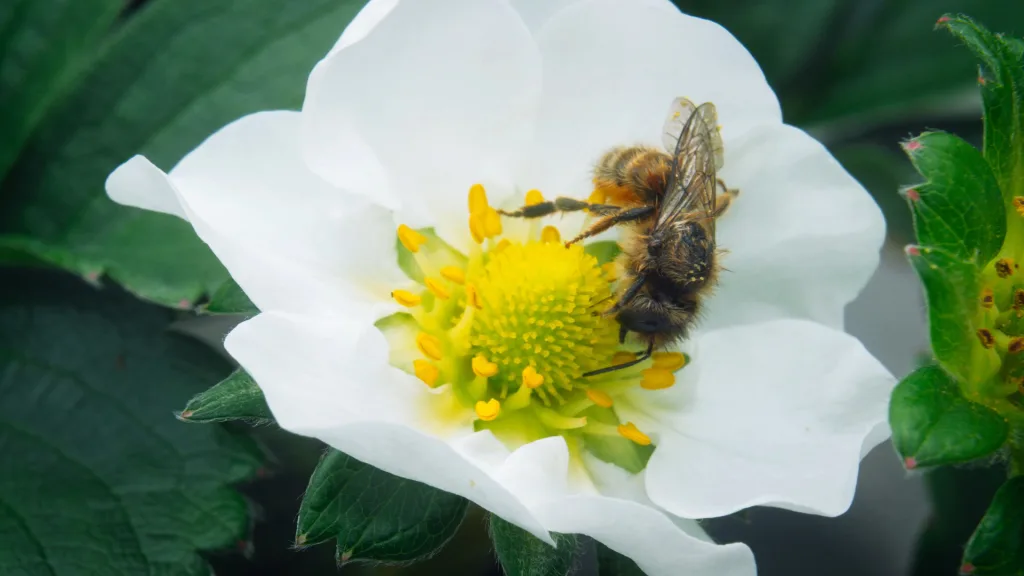
The robots toil away day and night, 24/7, all year-round, and because of that, they easily steal the show. But according to Reed, the bees are the real stars. “If the bees aren’t there, you will have zero fruit,” he says.
Oishii is the first U.S. company that has figured out how to use pollinator bees indoors, and therefore how to grow strawberries in vertical farms. (For those reasons, other vertical farms in the U.S. mostly grow leafy greens and herbs, while Driscoll’s, which controls about 60% of organic strawberries in the U.S., grows strawberries in traditional farms.)
The team declined to share exact details, but Koga says it took them one full year to understand how to “communicate” with bees. He says bees “aren’t stupid,” and they needed cajoling to leave their beehive in a sunless environment. It then took them another three to four years to increase pollination success rates from the initial 40-50% to the 95% it is today.
I didn’t see any bees on my visit, but it is surreal to imagine that this is a place where humans, bees, and robots all work in tandem, like citizens of a micro-society working toward the same goal: to grow fresh, clean, ripe fruits and vegetables—all year round.
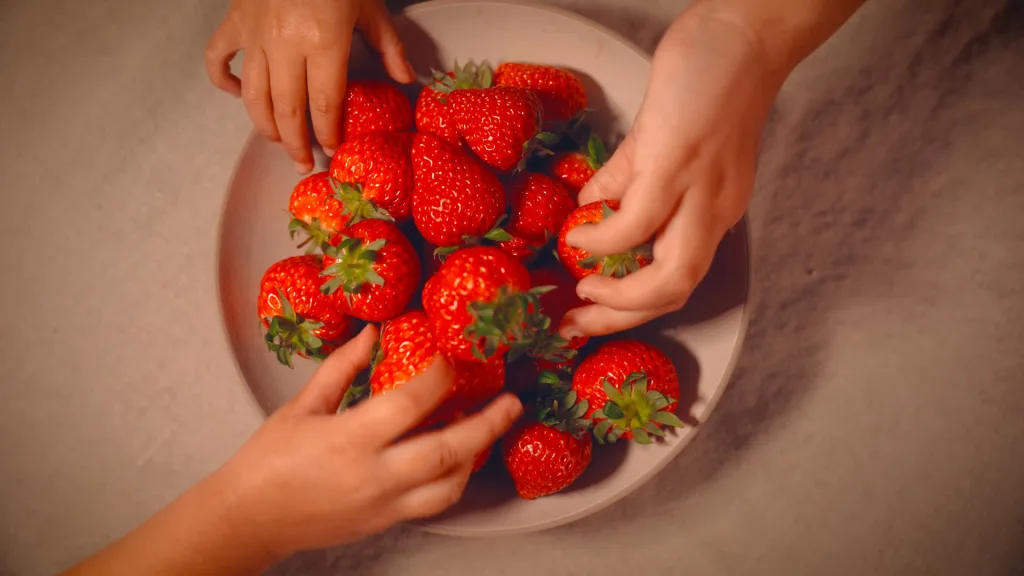
Beyond strawberries
From the beginning of Oishii, Koga recognized the untapped potential of the strawberry, which counts 148 registered varieties in Japan and only about a dozen in the U.S. A savvy entrepreneur, he also understood the marketing power of a berry. “It’s hard to build a brand with lettuce,” he says.
Koga has long described the strawberry as “the holy grail” of fruits, but the bees, while not new to the Amatelas farm, are a testament to the company’s quest to go beyond strawberries. Around one third of the crops we eat—apples, bananas, and potatoes included—need pollinators to grow, so when Oishii figured out the basics of how to grow strawberries in a vertical farm, they also figured out how to grow other produce. “Our goal is to launch a product that is multiple folds better than the conventional product, at the same price as the conventional product,” says Koga of the company’s future.
But before the company can accomplish this, and replicate its vertical farming operations in other parts of the U.S., it has to get the blueprint right. For Reed, the strategy has been twofold—farm better, and breed better cultivars—with both arms unfolding simultaneously. From the very beginning, Oishii has worked on optimizing its “grow recipe” based on about 20 inputs, including light, temperature, humidity, CO2 levels, pH levels, and airflow speed (to mimic the wind, which helps distribute the pollen powder.)

“Outdoors, you can’t test, you can’t say, ‘well, what if it was a little colder next year?’ So we’re able to learn from what we do each time to grow better strawberries,” Reed says. And while the team will continue to operate its old farm in Jersey City, they are also using their first farm in Kearny as an R&D propagation lab where they constantly optimize their grow recipes, as well as test and grow new strawberry cultivars and other produce. In December 2023, Oishii debuted cherry tomatoes that are as sweet as candy and cost $9.99 for a tray of eleven. And in their propagation lab in Kearny, New Jersey, they are already experimenting with melons. “The goal is to grow everything,” says Koga.
Oishii has more produce in the works, and many more farms in the pipeline, but Koga won’t say when these will open or where they will be located. For now, the company is eager to see what it can learn from the Amatelas farm, and how it can carry those lessons over to the next farm, and the next, and the next.